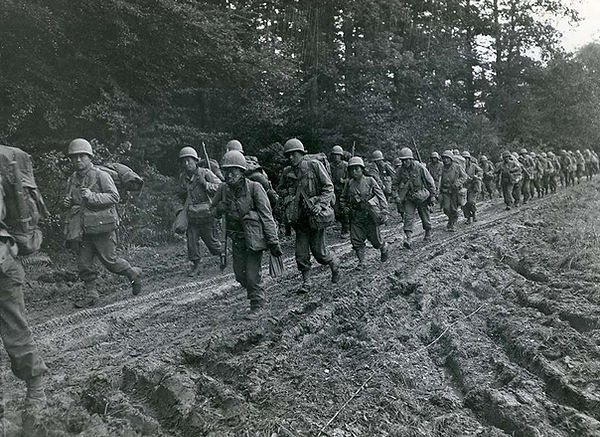

Extended

Heroism in a Segregated Military
Prior to Harry S. Truman's desegregating the armed forces in 1948, Americans who reflected non-dominant status were forced to serve in units segregated by race. Just like the Harlem Hellfighters, they were fighting a war on two fronts. Enemies on the battle field and bigotry at home.
And just like the Hellfighter, they didn't just stand up. They stood out.
The 442nd Regimental Combat Team

In WWII the 442nd (Japanese American unit) is remembered as the most decorated unit for its size and length of service in the history of the US military.
The unit, totaling about 18,000 men, was awarded over 4,000 Purple Hearts. 4,000 Bronze Stars, 560 Silver Star Medals, 21 Medals of Honor, and seven Presidential Unit Citations.
Native Americans in WWI & WWII

During World War I, Choctaw Indians from the 142nd Infantry Regiment, 36th Division became the first code talkers. Later Cheyenne, Comanche, Cherokee, Osage, and Yankton Sioux tribal member were recruited. In World War II, Navajo, Kiowa, Hopi, Creek, Seminole, and other tribes followed.
Hundreds of American Indians joined the United States Armed Forces and used words from their traditional tribal languages as weapons. Some tribes (Principally were recruited by the United States military to develop secret battle communications using their languages. Other Native people found one another during the war and informally used their languages to subvert the enemy. These “Code Talkers,” as they became known after World War II, are twentieth-century Native American warriors significantly aided the victories of the United States and its allies and saved who knows how many lives.
Hispanics/Latinos in the US Military
Hispanics / Latinos have fought in EVERY American war. Their commitment to answering their country's call is reflected in some of the units profiled here.
158th Infantry Regiment
The 158th Infantry Regiment, an Arizona National Guard unit of mostly Hispanic soldiers, also fought in the Pacific Theater. Early in the war, the 158th, nicknamed the "Bushmasters", was deployed to protect the Panama Canal and completed jungle training. The unit later fought the Japanese in the New Guinea area in heavy combat and was involved in the liberation of the Philippine Islands. General MacArthur referred to them as "the greatest fighting combat team ever deployed for battle".
PFC Guy Gabaldon
Private First Class Guy Gabaldon was a young Marine who single-handedly persuaded more than 1,500 enemy civilians and troops to surrender.

Guy Gabaldon (right) poses in a group that includes Japanese prisoners in 1944
PFC Guy Gabaldon (1926–2006) was raised in East Los Angeles where he grew up around people of all races, including Japanese-Americans. Through those friendships, he was able to teach himself to speak Japanese. Gabaldon joined the Marines when he was only 17 years old; he was a Private First Class (PFC) when his unit was engaged in the Battle of Saipan in 1944. Gabaldon, who acted as the Japanese interpreter for the Second Marines, working alone in front of the lines, entered enemy caves, pillboxes, buildings, and jungle brush, frequently in the face of hostile fire, and succeeded not only in obtaining vital military information, but in convincing over 1,500 enemy civilians and troops to surrender.
Inuits in the US Military
When the Japanese raided and occupied parts of Alaska during World War II, the Army called on native Alaskans to defend the northern territory.
Given no pay, more than 6,300 Alaskans -- aged from just 12 to 80 years old -- signed on to be sentries for the newly-created Alaska Territorial Guard.
Learn more in this book "Men of the Tundra"


Native Hawaiians in the US Military
Over 2,000 Native Hawaiians served in the United States Army during World War II
Herbert Miyasaki, (left), was Gen. Frank Merrill’s personal interpreter during the campaign in Burma, modern
